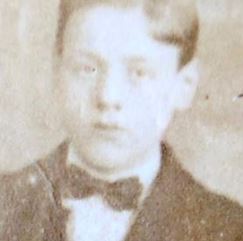Pte
Harold Thomson
Informationen zu Geburt
|
Geburtsjahr: 1897 |
|
Geburtsort: Bierley, Yorkshire, England, Vereinigtes Königreich |
Informationen zum Armeedienst
|
Land: England, Vereinigtes Königreich |
|
Truppe: British Expeditionary Force |
|
Rang: Private |
|
Dienstnummer: CH/2286(S) |
|
Einberufung datum: 03/12/1915 |
|
Einberufung ort: Birmingham, Warwickshire, England, Vereinigtes Königreich |
|
Einheiten: — Royal Marines, 1st Bn. (Letzte bekannte Einheit) |
Informationen zu Tod
|
Sterbedatum: 26/10/1917 |
|
Sterbeort: Bray Farm - Haus Kirchner, Belgien |
|
Alter: 20 |
Gedenkstätte
|
Tyne Cot Memorial Tafel: 1 |
Auszeichnungen und Orden 2
|
British War Medal Medaille |
|
Victory Medal Medaille |
Punkte von Interesse 3
| #1 | Geburtsort | ||
| #2 | Einberufung ort | ||
| #3 | Ort des Todes (ungefähr) |
Meine Geschichte
Private Harold Thomson served with the 1st Battalion Royal Marines (188th Infantry Brigade, 63rd Royal Naval Division). This Division took part in the Second Battle of Passchendaele on the 26th of October 1917.
The Division attacked with the 188th Infantry Brigade at 5:40 a.m.. The Anson Battalion and the 1st Royal Marines were to attack the objective with the 2nd Royal Marines were in support, and the Howe Battalion in reserve. The advance took place over a sea of deep mud, the Allied bombardment on German positions over the last 48 hours had turned the terrain into a mass of shell holes, flooded with several feet of water/mud. The 1st Royal Marines, on the left of the divisional front, managed to capture all their objectives, including Berks Houses, Banff House and Bray Farm. Enfilade fire, however, had caused heavy casualties.
Once the 1st Royal Marines had consolidated their gains, the 2nd Royal Marines renewed the attack. This failed, however, due to machine-gun fire from several concrete positions and defended shell holes around Sound Farm, which prevented a major breakthrough. By this time almost all company commanders of the attacking Battalions had become casualties and at 5 p.m. a strong German counter-attack caused the 2nd Royal Marines to retreat back behind the Paddebeek. By nightfall the troops in Banff house were forced to withdraw to Berks Houses. Practically the whole of the first objective had been gained except Source Trench and Banff House, with the four assaulting battalions suffering heavy casualties. The Division held this position until it was relieved on the 27th of October.
The War Diary of the 1st Battalion Royal Marines reports that “among the rank and file” 270 casualties were reported. Private Harold Thomson was one of them. Private Thomson has no known grave and is remembered at the Tyne Cot Memorial.
The Division attacked with the 188th Infantry Brigade at 5:40 a.m.. The Anson Battalion and the 1st Royal Marines were to attack the objective with the 2nd Royal Marines were in support, and the Howe Battalion in reserve. The advance took place over a sea of deep mud, the Allied bombardment on German positions over the last 48 hours had turned the terrain into a mass of shell holes, flooded with several feet of water/mud. The 1st Royal Marines, on the left of the divisional front, managed to capture all their objectives, including Berks Houses, Banff House and Bray Farm. Enfilade fire, however, had caused heavy casualties.
Once the 1st Royal Marines had consolidated their gains, the 2nd Royal Marines renewed the attack. This failed, however, due to machine-gun fire from several concrete positions and defended shell holes around Sound Farm, which prevented a major breakthrough. By this time almost all company commanders of the attacking Battalions had become casualties and at 5 p.m. a strong German counter-attack caused the 2nd Royal Marines to retreat back behind the Paddebeek. By nightfall the troops in Banff house were forced to withdraw to Berks Houses. Practically the whole of the first objective had been gained except Source Trench and Banff House, with the four assaulting battalions suffering heavy casualties. The Division held this position until it was relieved on the 27th of October.
The War Diary of the 1st Battalion Royal Marines reports that “among the rank and file” 270 casualties were reported. Private Harold Thomson was one of them. Private Thomson has no known grave and is remembered at the Tyne Cot Memorial.
Quellen 3
|
1 Royal Marine Battalion, (The National Archives, KEW (TNA), WO 95/3110/1 ). https://discovery.nationalarchives.gov.uk/details/r/C14303 Verwendete Quellen |
|
General Blumberg H E, Britain's Sea Soldiers : A Record of the Royal Marines during the War 1914-1919, (Devonport, Swiss & Co, 1927), pg. 332-336 Verwendete Quellen |
|
McCarthy C., Passchendaele. The Third Ypres, The Day-by-Day Account, (London, Uniform, 2018), pg. 146-147. Verwendete Quellen |
Weitere Informationen 3
|
Commonwealth War Graves Commission Database https://www.cwgc.org/find-records/find-war-dead/casualty-details/827623 |
|
Namenlijst (In Flanders Fields Museum) https://namenlijst.org/publicsearch/#/person/_id=1d3827e2-9577-4fc1-86cc-ce7b57640422 |
|
Lives of the First World War (Imperial War Museum) https://livesofthefirstworldwar.iwm.org.uk/lifestory/7679914 |
